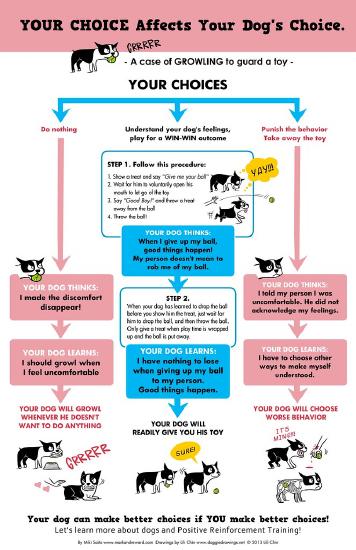Behavior Challenges: Resource Guarding
You may have heard that you should never disturb a pet while they are eating. The urge to safeguard a limited resource like food is a natural behavior. But what is happening when your pet is growling at you and no food is around? This could still be a form of resource guarding, where your pet tries to prevent others from accessing anything they consider valuable: a warm spot on the bed, a toy, a treat or even their favorite person.
Your pet may be thinking others will take what they have, and this activates their survival instincts. Though resource guarding is a natural behavior that we exhibit ourselves (see this video for a human comparison: What is Resource Guarding?), with our animals, this behavior can become dangerous if not addressed.
Resource guarding can be the result of lived experience. For example, a person reaches into a puppy’s mouth 100 times to take objects away. On the 101 time, the puppy sees this as a challenge and begins to fight back. Research also shows that resource guarding has a genetic component. But, no matter the cause, with careful training and trust-building, you can help your pet better manage these behaviors and decrease the severity of their reaction when a trigger is present.
Your pet may be resource guarding if, when you approach them, you see:
- The whites of their eyes
- A stiff body
- Head held lower than shoulders
- Lip licking
- Staring directly at you
- Growling
- Snapping
- Biting
Things they may do:
- Get up, take their resource and move away from you
- Eat faster
- Not allow you or a partner on the bed
- Not allow you to sit on the couch
- Growl at anyone or any pet who approaches you, even at home
- Hold their head over their resource while growling or showing the body language signals above
- Snap towards a hand that wakes them up from a nap
If you see any of these signs, it is important to immediately move away and never enter the power struggle. Trying to assert dominance, pick them up or push them off the bed can provoke a negative response, such as a bite.
What to do:
- If they show signs of discomfort with your approach, speak softly to them and slowly move away
- Call them from across the room, away from the resource, allowing them to voluntarily move away from it
- Leave them alone when they are eating and teach any children in the home to do this as well
- Make their pet bed a special place where no one is allowed to bother them
- Put away any problem objects (such as high-value chews or balls) until you have resolved the behavior
- Build a trusting relationship where their belief that you will take something from them is never affirmed (except in life-threatening situations like glass or poison)
What not to do:
- Never attempt to teach them “who’s boss” by reaching your hand in their bowl while they are eating. This only breaks trust and can leave you injured (Video: How to Create Resource Guarding)
- Never enter the power struggle. If you really need them to get off the furniture, distract them with a special treat from the fridge until they have forgotten all about the spot on the couch.
- Never allow children to touch a sleeping pet (it’s good for us to follow this rule also. Ask yourself: How Would You Like it?)
- Never trick them into giving something up. Snatching things away without their knowledge or a willing trade for something like a treat will only lead to more intense guarding in the future because trust has been broken.
If your pet is guarding from people (won’t allow a partner on a bed) or is growling at others who approach you, it is important to hire a certified professional dog trainer who uses fear-free techniques (see our Trainer Directory) to do this training with you where the behavior occurs. A board and train is not appropriate for this type of behavior modification, as it cannot replicate the people and places where the behavior occurs.

